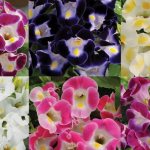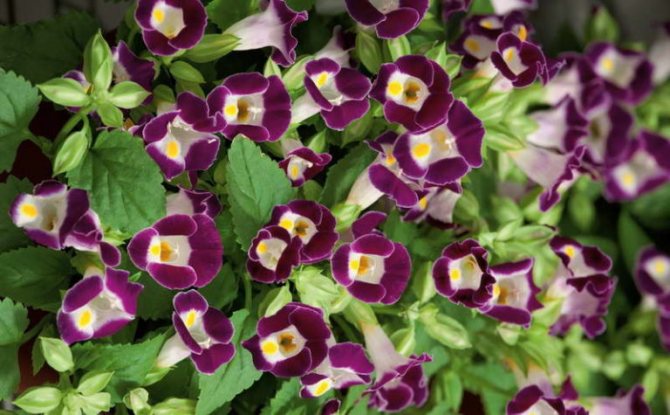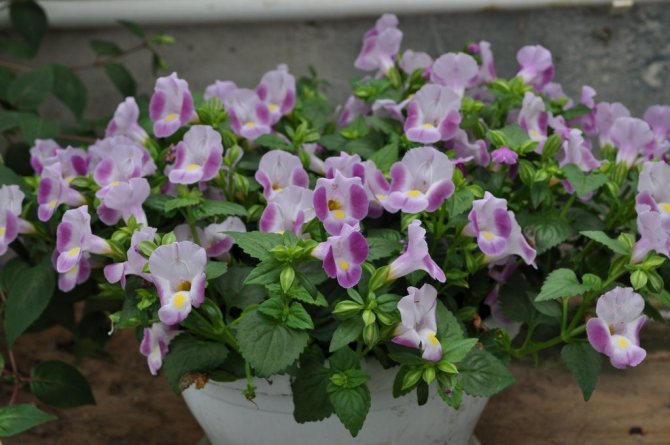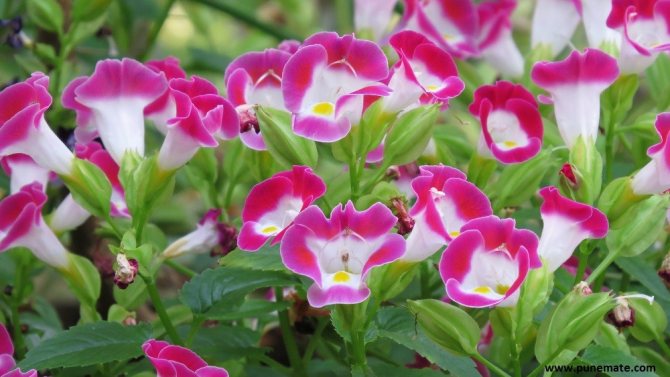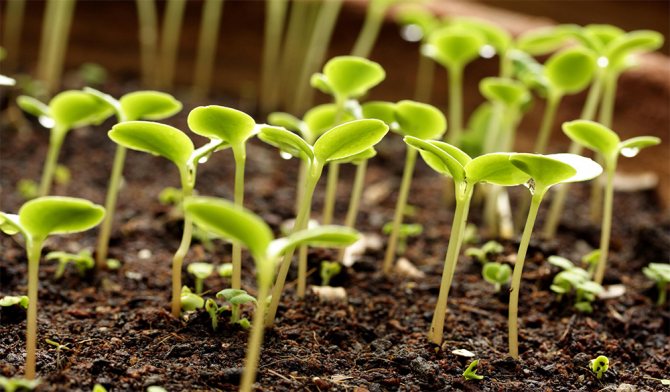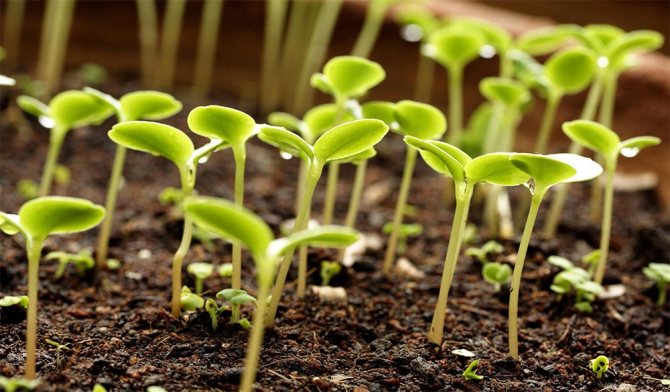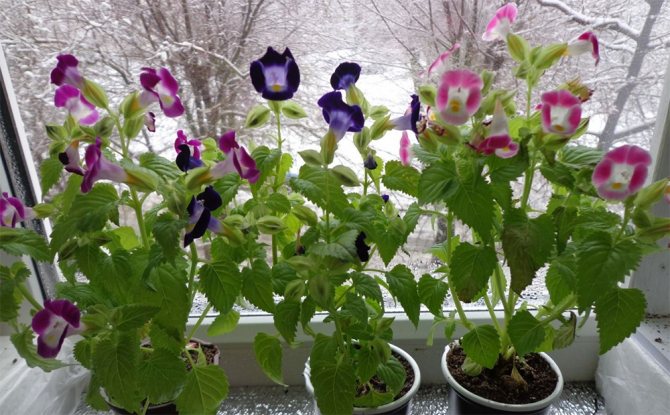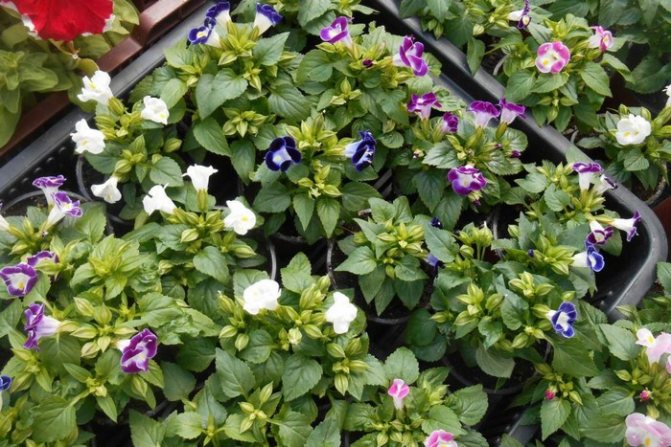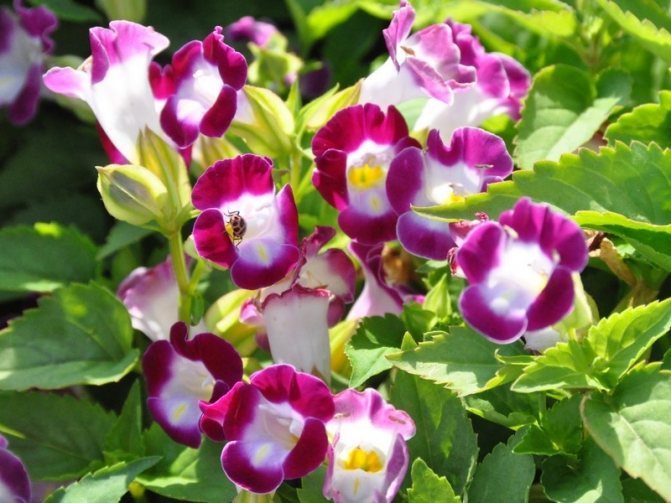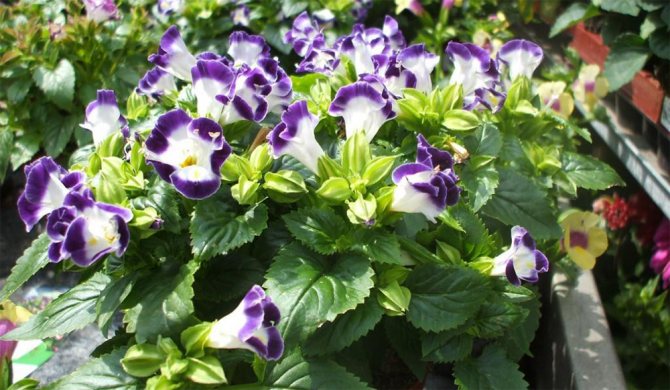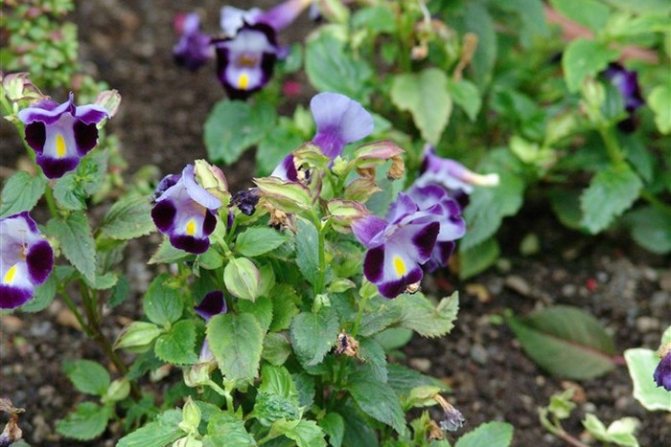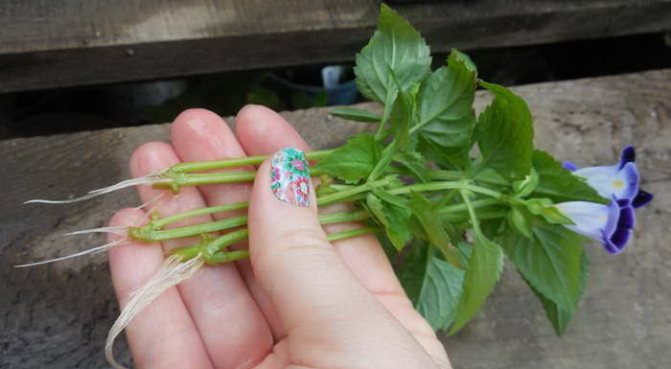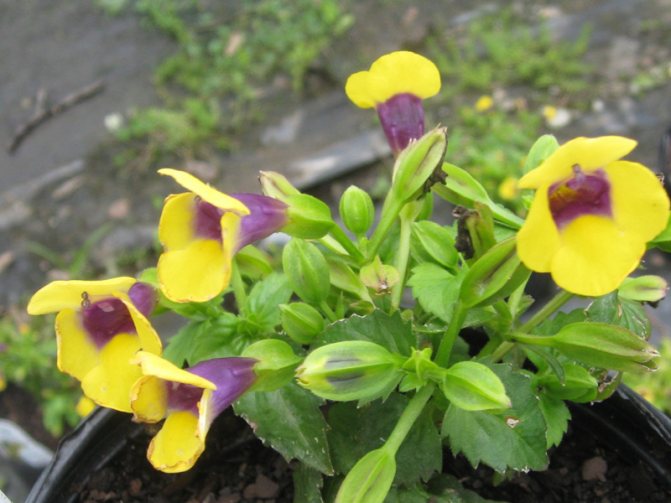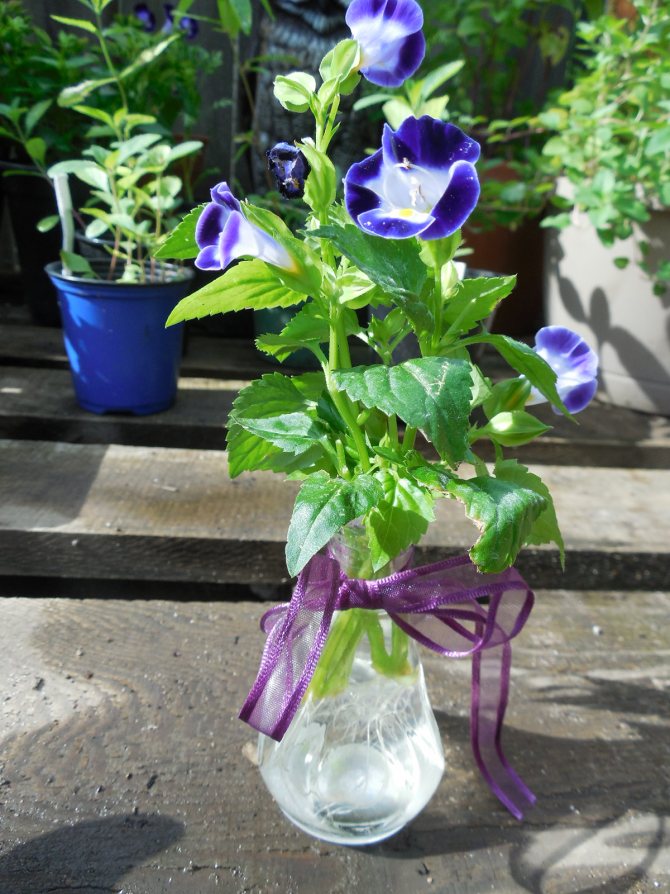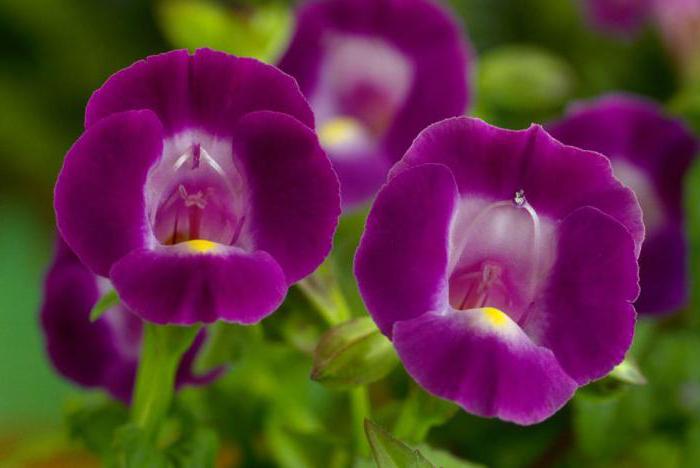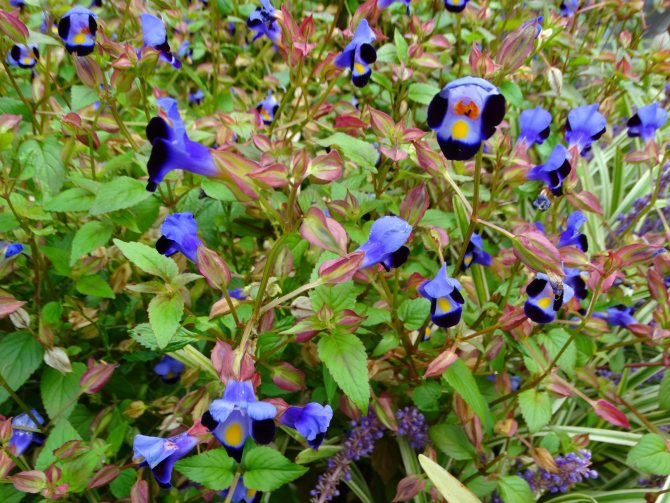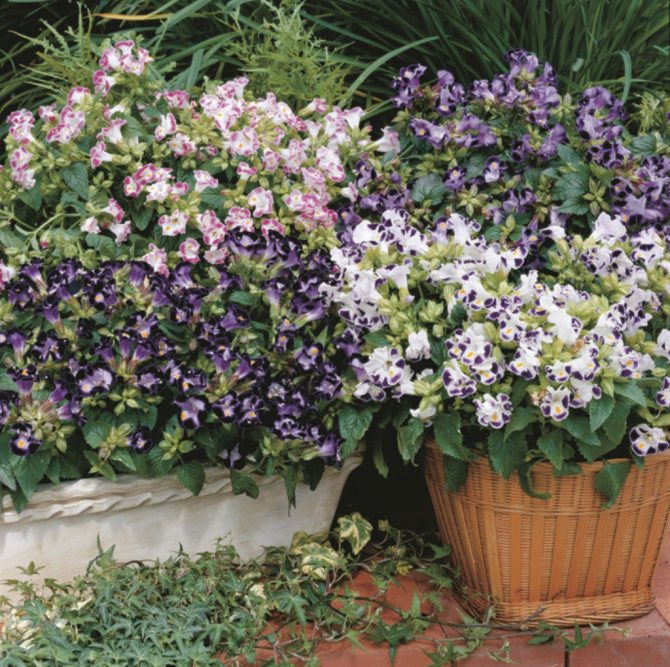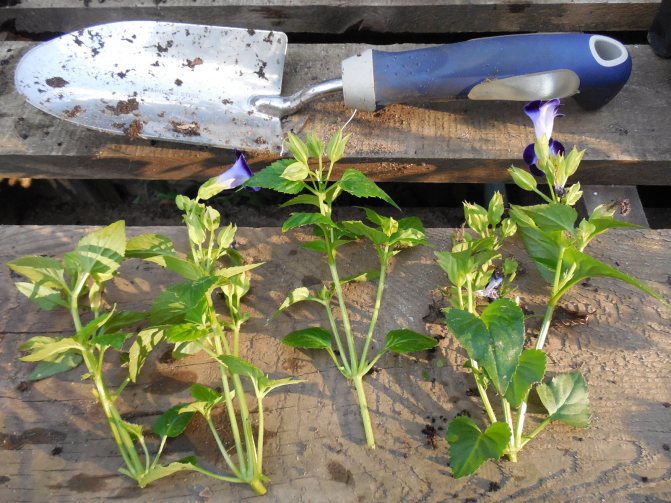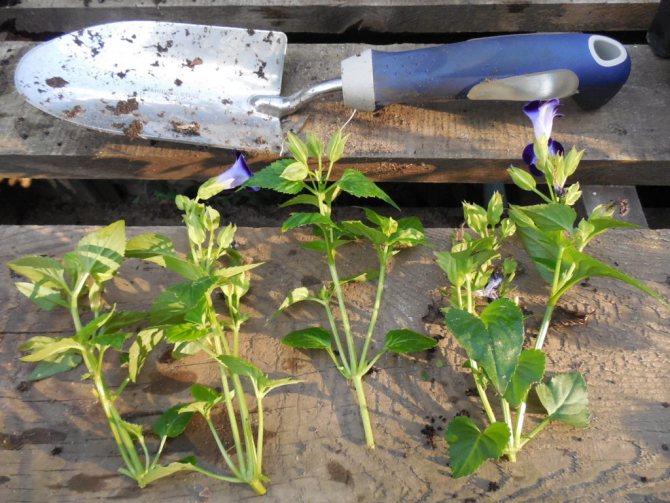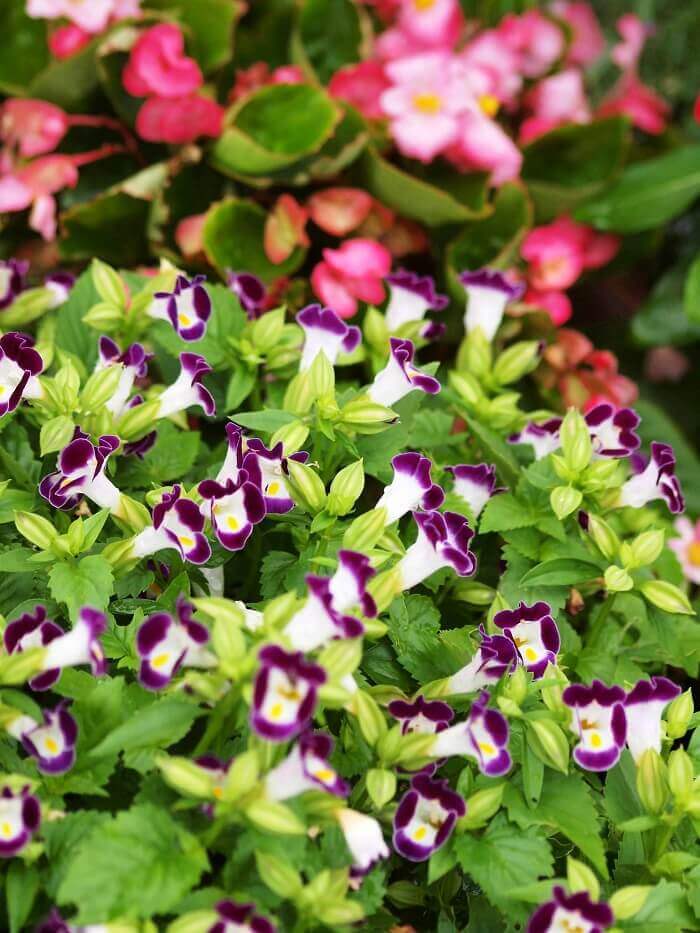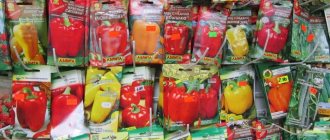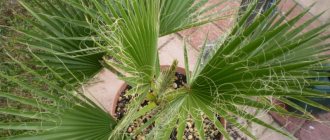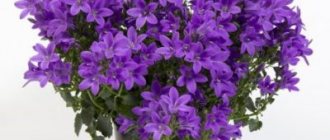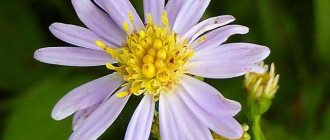The stem of this plant is creeping and quite branched, torenia rarely exceeds the height of 20–45 cm. The stem itself can grow vertically upward, its surface has the shape of a tetrahedron. A new young shoot appears from each leaf sinus, growing, it also begins to branch strongly. The leaf plates are located alternately on the shoot and have some sharpening at the top; the shape can take a simple, egg-shaped or obovate. Their length is 5 cm, there may be some jaggedness along the edge. Their color is rich or bright green. The petioles of the leaves are short.
Torenia flowers are her real pride. The flower-bearing stems of the buds are as short as those of the leaves. They usually begin their growth from the leaf sinuses and grow singly or in pairs. The flowers are somewhat reminiscent of gloxinia buds, since they have a light velvety surface that seems to glow. They are medium in size, with a rim similar in shape to a cylinder or a cone. The corolla is divided into 5 lobes, they are asymmetric. In this way, the flowers are very reminiscent of the open bud of the Snapdragon flower. The color of the bent part of the corolla is painted in a pale purple hue, the pharynx has a snow-white or pale lemon color. The bud has two lips and on the lower lip there is a small speck, of various shades: lemon, blue-blue or purple. An interesting feature of the flower is that the stamens (pair), together with the anther, are very similar in their bend to the brisket of a feathered bird; for this, in Old England it is customary to call toreniya the Wishbone flower (Bluewings). The flowering process in many species begins in the summer, and the buds delight the eye until the very cold weather.
After the flowers wither, seedlings appear, filled with yellow seeds. The fruits are so small that they do not spoil the decorative appearance of the plant, and they do not need to be removed.
There are some varieties that have very large flowers and the formation of their number is plural and avalanche. Corolla color also varies from variety to variety. Modern varieties F1 and F2 have been developed with excellent resistance to high summer temperatures.Their colors have a high color saturation and a variety of shades: dark purple, bright crimson, lilac-purple, corolla with lavender colors, with a tube in lilac tones and purple limb. Seed material is usually sold in mixes.
A distinctive feature of this variegated plant is that it is cultivated almost exclusively as a pot culture. The leaves of the "queen of bells" are very delicate and capricious, any violation of the growing conditions immediately leads to the fact that the deciduous mass begins to fly around, and since it is difficult to provide constant indicators for growing torenia in the open field, it is customary to keep it in home pots or containers ... If, nevertheless, the choice fell on her when used in landscape design, then they are limited to the use of:
- as the only potted decoration;
- as an ampel culture;
- in boxes installed on balconies;
- to create an accent in mixed phytocompositions grown in containers;
- in tall flowerpots or stone flowerpots;
- for decorating recreation areas, balcony or terrace structures.
Torenia: types and varieties for open ground
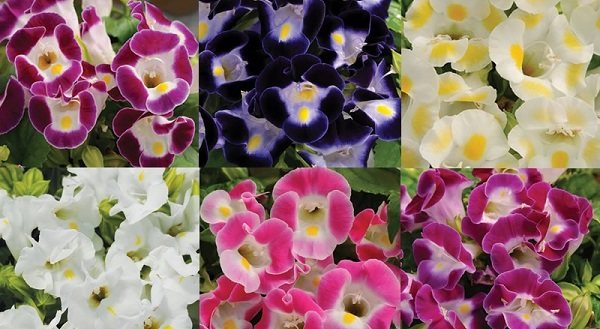
General information:
- herbaceous annual;
- the plant belongs to the Norichnikovye family;
- the homeland of torenia is the humid zones of Africa, the tropical regions of Southeast Asia;
- low bush with a creeping stem, medium size - up to 30 cm;
- medium-sized flowers are similar to gloxinia and orchid, the shade of the upper and lower "lips" are often different;
- the color of the petals is varied: white, crimson, lilac, pink, yellow, blue, purple;
- a lot of hybrid varieties have been bred;
- many varieties have bright spots on the lower lip;
- the plant is highly decorative;
- buds bloom in August;
- herbaceous perennial with spectacular inflorescences is grown in the open field and at home.
The herbaceous annual has many traditional varieties and hybrids. In natural conditions, botanists have counted more than forty varieties of Torenia. Many species have been cultivated, many interesting hybrid colors have been bred with a varied combination of shades of the upper and lower "lip". Before choosing a flowering decor for a garden, a summer residence, a balcony, it is useful to find out more information on the topic: Torenia, photos, varieties.


Kawaii
The original color of the petals: magenta and lemon drop. Unpretentious, drought-resistant annual. A highly ornamental plant - a spectacular decoration for any area. The Torenia Kawai variety is often used to decorate balconies and terraces.
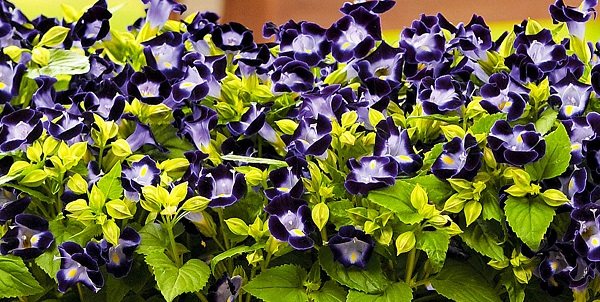

Yellow
Spectacular variety of herbaceous perennial. The bushes are lush, branched, the length of the stems is 25–30 cm. The petals are rich yellow, there is a bright purple spot on the lower lip.
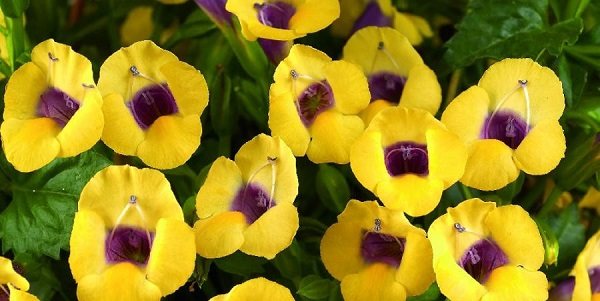

Kauai mix
Early flowering variety, ampelous type of torenia. Small bushes (up to 20 cm in height) have many flexible branches. Plants are compact, neat in shape, suitable for decorating balconies, loggias, growing in pots. Long flowering period, undulating ejection of buds. The highly decorative variety is often combined with other ampel varieties of torenia.
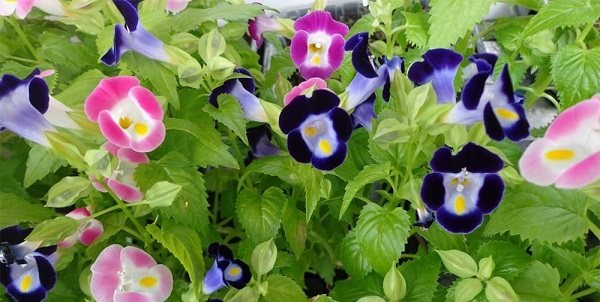

Fournier
A popular variety with highly branching elements. The plant is grown at home and on the site. The leaf plates are ovoid, long, the buds are on short peduncles. The shade of the petals and lips, most often - a combination of purple with deep blue. Breeders breed interesting subspecies with a new color of lips and petals.


Photo gallery of views
Growing seedlings from seeds
The best option for breeding on the site or growing torenia, as a pot culture for decorating balconies, loggias and terraces. They are engaged in seedlings from mid-February.To increase the percentage of germination, it is useful to treat the planting material with growth stimulants.
After planting, the soil is sprayed, covered with glass or polyethylene is used: it is important to maintain a high humidity of the environment during the "black earth" period. Every couple of days, the mini-greenhouse is opened slightly for 15 minutes: ventilation interferes with the development of mold. Condensation is also removed.
Soil and capacity
For germination of seeds, peat pots, a common container or a wooden box are used. Nutritious, lightweight substrate contains charcoal and sand, peat, garden soil.
You can buy potting soil from a flower shop. The prepared substrate is calcined to kill fungal spores. Another option for disinfecting the base is to water the soil with a strong solution of potassium permanganate.
Seedling care
After the appearance of the first seedlings, the protective layer (polyethylene or glass) is removed, and fresh air is opened. The container with torenia sprouts should be kept in a room with a moderate temperature: during the germination of the seeds, the optimum performance is about + 20..21 ° С. For sprouts, a cooler environment is needed - about + 18 ° C, otherwise the seedlings will grow earlier than it gets warm enough outside, and frost on the soil will stop.
Seedlings are grown taking into account the recommendations:
- watering. They moisten the substrate in time, monitor the condition of the soil: waterlogging is not needed, but the dryness of the base also interferes with the active growth of seedlings. The water is settled, always warm. Periodically loosen the substrate with a miniature tool;
- temperature. You cannot keep peat pots with seedlings in a hot room, in direct sunlight. Do not allow seedlings to dry out in a stuffy room. With a lack of light, the sprouts stretch out strongly in search of the sun, become thinner, weaken. The optimum temperature for growing torenia seedlings is about + 18 ° С;
- picking. With the formation of two leaves, it is time to transplant the grown seedlings into separate containers, if the plants were in a common container. They act carefully, having previously moistened the substrate. A pick is stress for plants. After transplanting, it is useful to water the soil with Zircon or Fitosporin immunomodulators to support the seedlings of torenia under the influence of negative factors;
- hardening. A mandatory procedure, without which you can not plant seedlings on the site. Preparation continues for two weeks. The first two days, the seedlings are on the balcony for a quarter of an hour, then - 30–40 minutes, after four to five days - 1–2 hours, and so on. After two weeks, hardened seedlings should spend the night in the fresh air. It is important that there is no frost, otherwise the sprouts will freeze.
Transplanting
Torenia sprouts are transplanted to the site only after the frost stops. It is important that the air temperature is at least + 16..18 degrees. Seedlings are pre-hardened (the rules are described above).
To plant seedlings, you need a warm day, preferably with high clouds, but in the absence of rain. Strong wind, fog, heat are negative factors that negatively affect the newly transplanted sprouts of an ornamental plant.
Location selection and lighting
Warmth, sufficient light level - optimal conditions in regions with a temperate climate. If a low-growing decorative species is planted in hot areas, then it is useful to choose an area with light shading so that delicate stems, leaves and buds do not get burned from the scorching sun.
For planting, a site is chosen not in a draft, without swampiness, with a nutritious and loose substrate. It is harmful if the plant is faced with sudden changes in temperature.
On a note! It is important that there are no stones in the soil: the plant is demanding on the quality of the soil.It is imperative to remove weeds from the site, to loosen the soil: harmful grasses often "clog" a low-growing annual with thin, often creeping, stems.
Landing rules
It is important to take into account the advice of experienced florists:
- check the site, remove weeds from the roots, loosen wet, slightly dry soil;
- dig small holes for each seedling. An interval of about 20–25 cm is observed between the pits;
- preliminarily moisten the soil in moderation, make a little organic fertilizers, then dig up the substrate, carefully level the surface;
- they lower the sprouts into the holes, sprinkle the roots with earth, tamp them a little. It is not necessary to deeply deepen the young torenia;
- after planting, under each bush, add a little settled, moderately warm, water, wait until the moisture is absorbed, mulch the planting zone;
- feeding is performed after 10 days;
- young plants are watered moderately, make sure that the weeds do not grow more actively than the herbaceous species, periodically feed them.
Lighting
For normal growth of torenia, bright lighting is necessary, but the plant should be shaded from the midday rays of the sun. In autumn and winter, indoor flowers must be provided with artificial lighting. Set aside a place in the garden to protect from rain and wind.
It is not advisable to plant these flowers in an open sunny flower bed, it will be better if they are in partial shade in the afternoon, since the hot rays of the sun are detrimental to the delicate greenery of plants, their leaves will wither and dry.
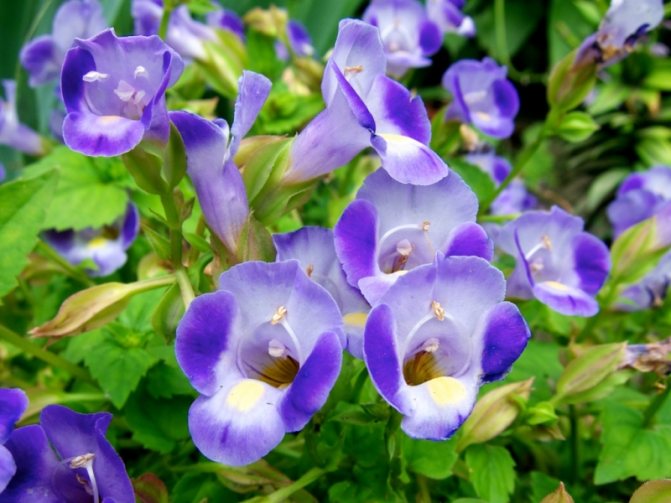

Outdoor care
A fairly unpretentious plant of torenia develops well in partial shade and under moderate light. "Transparent", thin crown of trees on the site does not interfere with abundant flowering and, at the same time, prevents the harmful effects of the scorching sun.
The main activities for the care of a herbaceous annual: moistening the substrate, introducing organic matter and minerals, loosening, weed control, mulching. A transplant of an annual species is not carried out if there are no serious indications, for example, infected plants have appeared on the site: a virus, fungus, dangerous bacteria.
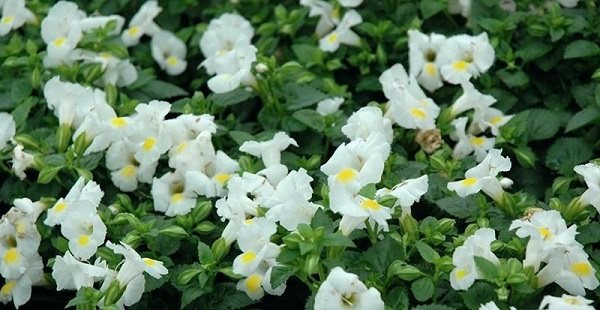

Watering
Short periods of dryness are less damaging to tilling than a clayey, dense substrate and islands of water near bushes, but it is more beneficial to stick to the golden mean. The soil is moistened as the top layer dries, taking into account the volume and frequency of precipitation. Plants are watered often enough, but the amount of liquid is moderate.
Important nuances:
- During the ejection of buds, you need to carefully monitor the level of moisture in the soil: with a strong dryness of the substrate, the flowers often wither and fall off, or bright colors please the eye for a shorter period.
- During watering, they act carefully: use a watering can with a long, narrow spout so that drops do not fall on the buds and leaves.
- Do not add cold liquid to the substrate.
- Rare loosening increases the risk of soil salinization, a dense crust forms, which impairs soil aeration.
Violation of the usual state of the environment negatively affects garden flowers. Fitosporin is a natural remedy that stimulates the immune defenses and vitality of plants. On very hot days or with sharp temperature fluctuations, it is useful to water the toria with a working solution based on succinic acid.
Top dressing and fertilization
Mineral compositions and not very strong organic matter are introduced during the growing season and flowering: natural and synthetic components alternate. Top dressing is carried out every two weeks.
The soil is immediately moistened, then nutrients are added. For a set of green mass, in the first period (vegetation), toasting should receive more nitrogen and phosphorus, during the ejection of buds and with the beginning of flowering, the concentration of Na is reduced, and potassium is increased.
Care during and after flowering
It is useful to water the undersized species on time, loosen the substrate, weed immediately so that the weeds do not interfere with the growth and ejection of buds. All faded elements are removed in time, which activates the formation of new buds. Be sure to apply mineral fertilizers containing potassium.
On a note! If the plants are planted in an area with optimal illumination (with a slight shade during hot hours), then torsion will certainly delight the look and refresh the area.
Bush formation
For the first time, the grown seedlings are pinched: the length of the shoots reaches 8 cm. In young plants, after transplanting into a flowerpot or on the site, pinch the upper stems: the plant bushes more actively. If necessary, remove all rotten, dry, broken, damaged by fungus elements from the torsion. In varieties that resemble a ball, it is useful to maintain the optimal shape of the bush: at the beginning of summer, while there is an active growing season, they pinch the stems in the right places.
Mulching, loosening
When growing torrential in flowerpots and on the site, it is useful to periodically fluff the soil for more active aeration. Loosening is performed on a soft, loose substrate, which is pre-moistened. Weeds are removed along the way.
Peat mulch is poured in a thin layer under each bush when planting seedlings, renewed as needed. Peat not only actively nourishes the soil during irrigation, but also prevents weeds from breaking through the mulch layer.
Growing and care
Torenia loves warmth, needs moderate lighting, can grow in partial shade in warm climates, and tolerates open sun in southern regions with good watering. A plot for cultivation is needed with protection from cold drafts, the soil is required loose, fertile, with the addition of sand and charcoal, sufficiently air and water permeable.
When caring for the theory, you need abundant watering, loosening the soil, cleaning weeds, and periodic feeding with complex mineral fertilizers. During watering, do not allow moisture to get on the flowers. To form a compact bush, pinch the top of the shoot, remove the wilted flowers so that decorativeness does not decrease.
Torenia does not tolerate low temperatures, it can die even from small frosts.


Blooming torenia of various colors in a container
Protection from pests and diseases
Torenia rarely gets sick with proper care. Withering and drying out of the stems is possible with a lack of moisture, with excessive watering - the development of a fungus. They fight mold on leaves, stems and soil with the help of antimycotic agents - fungicides: Topaz, Skor, Bordeaux liquid, Hom, Fundazol, copper-containing compounds. The drugs are used according to the instructions. With the active spread of the fungus, experienced flower growers advise to dispose of the diseased bush so that mold spores do not get on neighboring plants. Next, the area must be disinfected.
Important nuances:
- When harmful insects are identified, parasites are collected by hand, all parts of the torenia are examined.
- With a small number of colonies, folk remedies are used to treat infected plants: soap solution, garlic tincture, tobacco decoction. With active reproduction of pests, insecticides are used.
- When populating a spider mite against the background of a dry environment, chemicals of a different group are used to destroy pests - acaricides.
- It is important to normalize growing conditions, to prevent waterlogging and drying out of the soil.
- To prevent the colonization of parasitic insects and mites, it is useful to prepare the soil according to the rules, and the purchased substrate must be disinfected.
- Thickened landings should not be allowed: the lack of space for growth and development makes the plants weaker, it is easier for pests to move from bush to bush.
- When using chemicals, the florist must protect the body from contact with acaricides and insecticides.You will need closed clothing, a hat, plastic glasses, thin rubber gloves, and a respirator. Neglect of simple safety measures increases the risk of vapors and drops penetrating the skin, mucous membranes, respiratory tract and eyes.
How to care for seedlings?
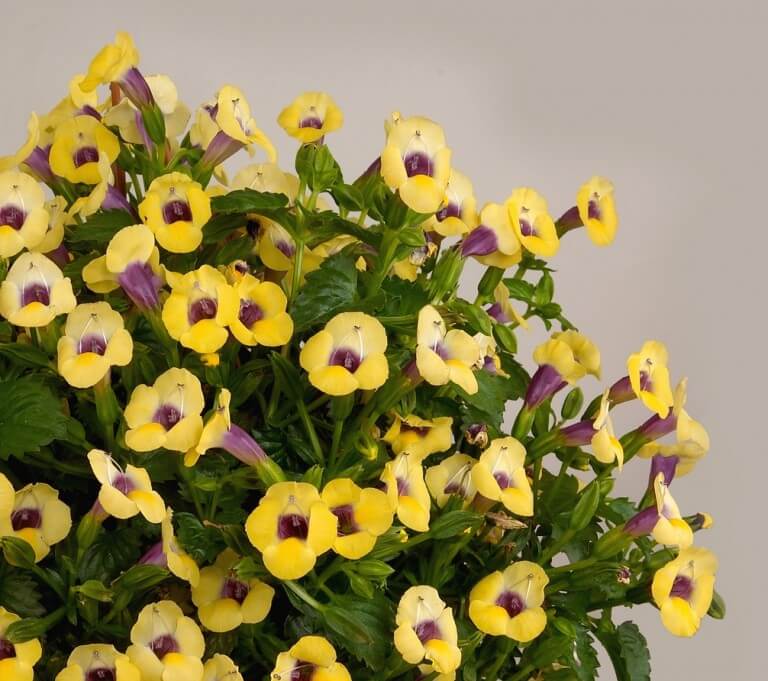

Pots with seedlings are placed in a warm place so that the temperature is kept around +25 degrees. Otherwise, the seeds will not germinate. Remember to keep the substrate moist. Observing all the recommendations, you can see the first shoots in a week and a half. If the air temperature in the room was slightly lower than indicated, the shoots will germinate later, but no later than 18 days. When the seedlings "hatch", you can reduce the temperature regime. The first 3-4 weeks, the seedlings are moistened every day from a spray bottle. After the appearance of the third leaf, the seedlings dive into the peat containers. Pinching the tops is done when the sprouts gain a height of 5 cm - this method is used to obtain thicker bushes. If you live in a warm region, seeds can be placed directly in an open area immediately after frost.
Reproduction
Torenia is bred at home and on the site only with the help of seeds. They are engaged in seedlings according to the recommendations given in the previous sections. Some growers sow seeds directly on the site, but only in warm regions do bushes and flowers have time to form.
Remember: buds are formed in August, when grown in a seedless way, the flowering period occurs in autumn with an unstable temperature regime and less favorable conditions. Weak bushes bloom worse, get sick more often.


Description of the plant
Torenia got its name in honor of Red Olaf Toren. He was a student of Karl Linnaeus. While in India, Toren sent samples of this flower. Having a variegated color, the plant received the second name "clown flower". Previously, the perennial was considered one of the Norichnikov species. Today he is a representative of the Lindernievs. Torenia fournieri is the most common Torenia variety that can be seen more often in flower shops. Has blue-violet flowers. The plant begins to bloom in spring. Abundant flowering continues, without stopping, almost until the end of autumn. In winter, if desired, the flower is brought into a room where the air temperature does not exceed +8 degrees.
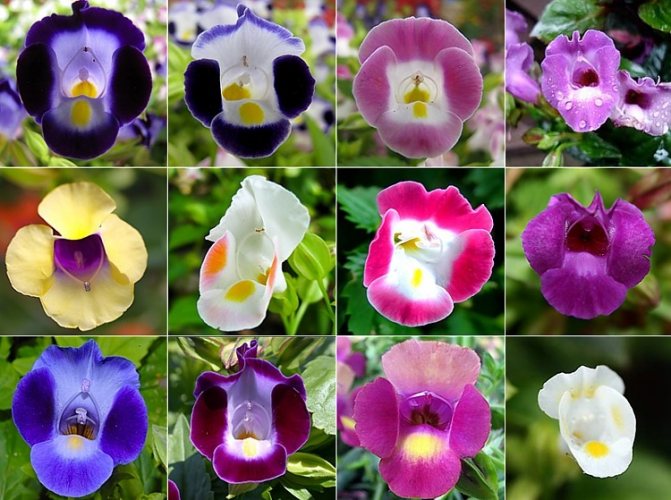

Torenia in landscape design
Note to amateur flower growers:
- Low, compact and ampelous varieties of highly decorative annuals look good against the background of a well-groomed, green lawn.
- An interesting planting option: a combination of bright colors of decorative tobacco, torenia and petunia.
- Ampel varieties with creeping elements are a delicate, spectacular decor for hanging pots and decorative, fairly tall floor vases. Places compositions on the loggia, balcony, terrace, decorate the patio area.
- You can equip a low curb from torrenia, but varieties with creeping stems are not planted close to the edge of the paths. Low-growing, compact varieties, similar to large balls, are suitable for the design of this zone.
- Plantings of torrenia give fresh notes to the garden and summer cottage, in which several varieties are involved with a similar bush shape, but different shades of petals.
- You can pick up two or three varieties with rich crimson, lilac, yellow, white petals and a lip that has juicy color spots.
- Tory landings are never boring, especially when using the optimal combination of tones.
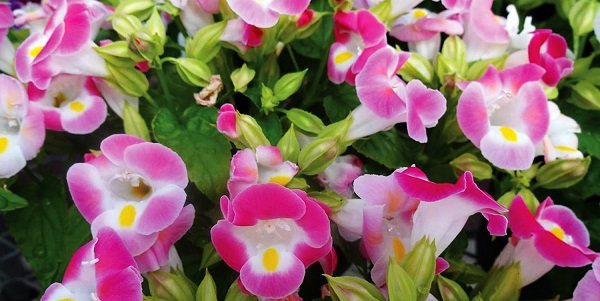

Suitable companion plants:
- Marigold.
- Salvia.
- Aquilegia.
- Verbena.
- Nasturtium.
- Sulfinium.
- Petunia.
When combined with other plants, it is important to take into account what type of low-growing flower grows by the florist: ampelous or ground cover.
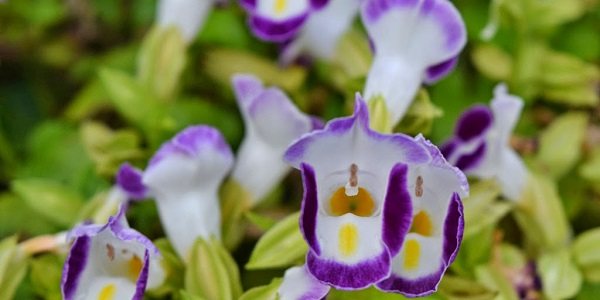

Torenia is an interesting herbaceous species for decorating a garden, balcony, patio area. Unusual flowers combine signs of orchid and lobelia, rich green hues complement the bright colors of the buds. It is quite simple to grow torenia from seedlings, the germination of seeds is sufficient. In general, the plant is unpretentious, and every year it is gaining recognition from an increasing number of amateur flower growers.
Want to know more useful information about growing Torenia? Watch the following video:
Torenia as an indoor flower


When growing a flower in a home, the air temperature should be +16 - +18 degrees. It is imperative to regularly ventilate the room, preventing temperatures above the established norm. In the colder months, the temperature of up to +8 degrees will be sufficient for the flower. The air must be humidified. To do this, use conventional spraying. It is better if the plants in containers are placed on a tray with wet pebbles. Waterlogging of the soil is unacceptable, but you do not need to skip regular watering. Torenia is usually watered every 3-4 days. Moistening is carried out when the top soil layer dries out.
3. Varieties:
3.1 Torenia fournieri
A beautiful, abundantly flowering, annual, shade-tolerant plant that will bloom even when grown in partial shade. The flowers are large, funnel-shaped, often 2 shades - with 4 rounded, fused purple or pink petals and a white or yellow throat. The leaves are oblong-oval green, oppositely located on the stems. The surface of the leaf blade has a slight pubescence, and the edges are small denticles.
↑ Up,
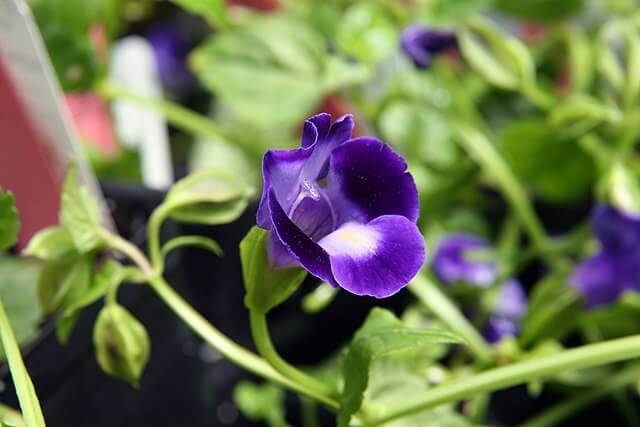

Landing
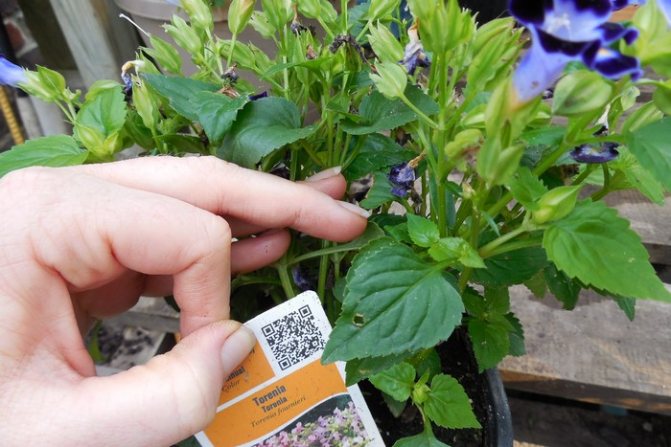

Vietnam is a warmer country; Torenia grows in the shade. We grow toria in partial shade. The best solution is early sun before 10, then light shading. Can be grown in light shade under trees on any side except the north. If sufficient moisture is provided, the substrate can be grown on the south side, provided that this is not the sill of the south window, because the sun through the glass will create hell for torching. A balcony box will be a good option, provided that the soil is constantly moist.
Torenia care
Landing place. Torenia is a very light-loving plant. On the east or west side of the site, she will feel great. In the shade, the planted seedlings will quickly stretch out, they will be kvola and the long-awaited flowering will not please.
The soil. Torenia grows in almost any soil. However, in sandy loam and loamy soil with neutral acidity, the flower grows luxurious.
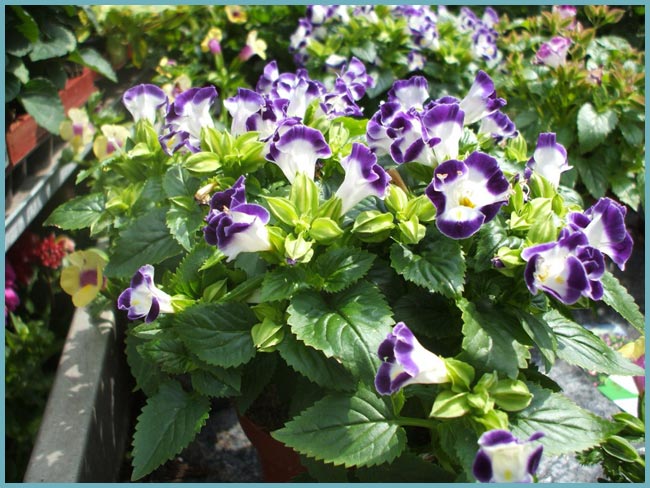

When choosing a place for planting torenia, remember that the plant really needs sunlight.
Fertilizer. Torenia is very responsive to feeding. You need to feed the plant every two weeks. For this, special mineral fertilizers are used for flowering plants. Fertilizers are applied when watering.
Advice. Mineral fertilizers should first be dissolved in water and applied to the soil when watering. So the torenia bush will quickly receive its portion of "food".
Watering. Watering is required moderate and regular. Stagnant water should be avoided. After watering, the soil around the plant is loosened, allowing air to circulate in the root zone.


Make sure no water stagnates around the plant
Diseases and pests. With prolonged rains or waterlogging, slugs may attack. Of the diseases in this case, root rot is dangerous. In the dry season, aphids and spider mites are dangerous for torning. At the first signs of trouble, plants are repeatedly treated with special pest control agents.
Torenia grown from seed grows rapidly with proper care and blooms profusely throughout the summer. Faded flower stalks need to be removed in time, thereby freeing up space for new buds.
Growing a flower at home
To decorate your premises with this delicate flower, you can easily grow them yourself in room conditions.
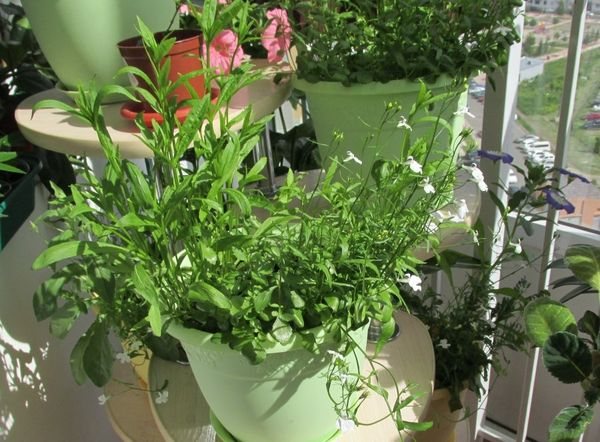

Torenia lends itself to indoor cultivation
Landing
Planting is not difficult: the main thing is to purchase seeds from well-known manufacturers and have a desire to engage in floriculture.
Features of growing from seeds
Sowing flower seeds begins in early March. To do this, you must have a container for seedlings with a height of at least 12 cm, it must have drainage holes to drain excess water after irrigation.
If there are no holes, then they must be made in the right quantities so that the root system of the seedlings does not rot or the earth in the container does not acidify.
The soil in the container is moistened in any way and grooves are made along the length of the container. Planting parameters:
| Distance between grooves | not less than 5 cm |
| Step in a row between shifts | 3 cm |
| Planting depth of seeds | 0.5 cm |
| Air temperature | +21 |
| Germination rate | about 2 weeks before the first visible results |
After sowing the seeds, cover the container with glass and put it in a bag, this will improve seed germination.
When the seedlings have 2 true leaves, they are seated in separate containers no more than 200 grams. For this purpose, disposable cups are suitable, only holes are made in the bottom for draining water.


Remember to make holes to protect pets from overflow
Soil preparation
In the flower garden, the soil is dug up, and various weeds are removed, which will interfere with the growth of young seedlings. If there are a lot of weeds, you can use Roundup, which removes even perennial weeds.
It is good if there is an opportunity in the fall for digging at the site of the future flower bed to bring rotted manure or soil from a compost heap.
It is necessary to level the soil so that there are no large stones of the earth after digging.
Step-by-step planting process
Seedlings are transplanted into open ground only after hardening the seedlings. Seedling hardening is when it is gradually accustomed to a new place of residence in the open field. She is first taken out for a couple of hours, then by the end of the second week she is already left to spend the night on the street.
On the flowerbed, markings are made where holes for planting seedlings will be dug. After that, pits are dug out and a little wood ash and humus are added to them. The Torenia seedling is carefully removed from the container and, without destroying the clod of earth, falls into the hole.
After that, the soil is slowly poured from all sides and squeezed by hand to remove air cushions from the soil. This will stimulate better acceptance in the new location. After that, the planted seedlings are well watered with warm water.
If the weather is hot and sunny, then a layer of mulch should be spread around the seedling, which will help reduce moisture evaporation and at the same time shade the young plant.
Care after landing
In order for the flowers to grow well and delight with their flowering, the plant must be given the proper care.
Humidity and watering
Air humidity in summer can be any, since the flower does not need high humidity. In winter, if the flower is left in the second year of life, the leaves are sprayed from a spray bottle.
This is done, since hot air comes from the batteries, and it dries out the air in the room.
Watering in the summer should be abundant and timely. Therefore, when the heat comes, watering is done daily. After each watering or heavy rain, loosening and simultaneous weeding of weeds should be carried out.
When watering Torenia, do not fall on the opened buds.
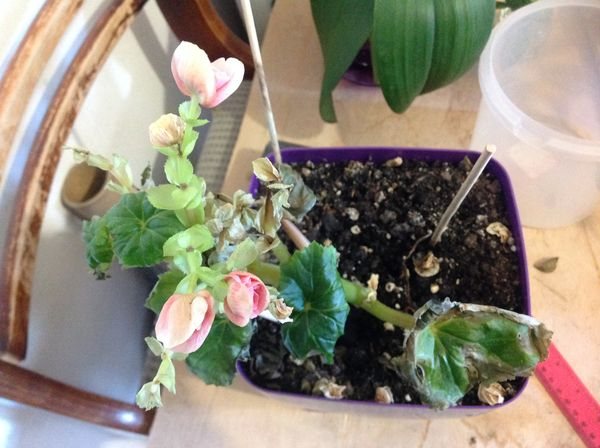

Watering frequency depends on seasonality
PICTURE The battery dries the air in winter, which negatively affects the flowers
Winter watering should also be regular, but it is reduced compared to the summer regime.Watered over not much warm, settled water. The soil in the container where Torenia is planted should not completely dry out.
In winter, when the room temperature drops to 12 degrees, watering is greatly reduced so as not to cause rotting of the plant root system.
Temperature and lighting
Temperature
It tolerates any summer air temperature and therefore the higher the air temperature, the more watering the root system needs.
It is necessary that there are no large temperature differences between night and day.
Light should be medium and can grow well in the lacy shade of trees. If it is planted on the south side of the house, then the plant will need to be provided with more abundant watering.
It is worth placing the container in a place where there is no draft.
It is better to provide lighting scattered without direct rays Drafts are contraindicated Torenia
Sowing torenia seeds
Sowing of seedlings is carried out at standard dates - at the end of February or in the first half of March.
Torenia is sown according to the standard technique:
- The containers are filled with soil and leveled lightly, being careful not to tamp.
- The soil surface is gently moistened.
- Torenia seeds are sparsely sifted over the surface and covered with a thin layer of sifted soil or sand.
- Crops are re-moistened.
- The containers are covered with foil or glass and placed in a comfortable environment.
Selection of seeds for sowing
Torenia belongs to a fairly common summer plant, but to grow plants from seeds, you should be responsible for their choice. To grow, you need to carefully study the information about the manufacturer and the characteristics of the variety, the timing of sowing. It is better to choose trusted firms and garden centers, in the good quality of the seeds of which you are convinced.
The too low price and lack of information should be alarming: low-quality seeds of torenia come across quite often, surprising with extremely low germination. But seeds from trusted producers can be purchased for 2-3 years, without loss of germination (about 98% percent under optimal storage conditions).
Self-collection of seeds of torenia, especially from potted and indoor plants, allows you to get a large number of seeds even from one plant. But since for the ripening of fruits you need to sacrifice flowering, and almost all varieties of hybrid origin, it is difficult to preserve their characteristics and achieve the desired with such reproduction. Therefore, more often this plant is grown from purchased seeds.
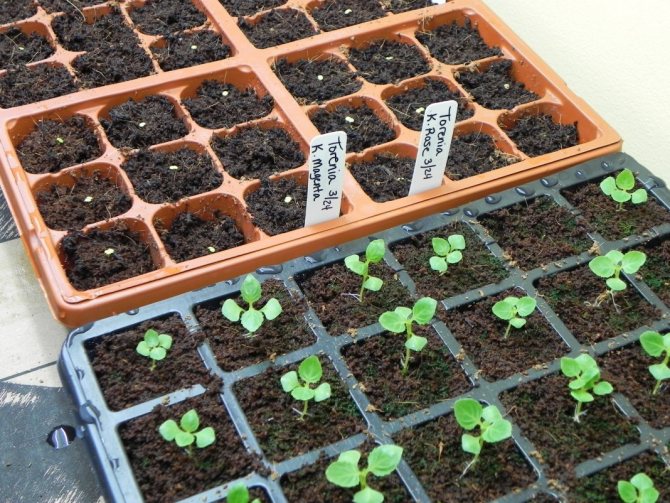

Sowing seedlings. <>
Conditions for seed germination
For growing seedlings, both temperatures and light intensity are important. The optimum temperature for sprouting torenia is about 23 degrees. If the weather is cloudy or it is not possible to place the plant on a bright southern windowsill, it is better to arrange supplementary lighting. For tilling, maintain a stable light soil moisture without drying out the soil.
The first sprouting of torenia may appear as early as 5 days, but mass sprouting usually appears approximately 2 weeks after sowing.


Seedlings of torenia sown for seedlings. <>
Soil and containers for sowing
Torenia is sown in shallow large containers or bowls with good drainage holes.
The substrate for this summer can be used universal for growing seedlings. A simple mixture of garden or all-purpose potting soil with vermiculite or sand will do. For diving, you can use special earth mixtures for geraniums (pelargonium). If possible, a hydrogel can also be added to the soil to stabilize moisture and protect it from drying out. Before sowing, it is advisable to disinfect or ignite the soil.
Planting seedlings
The plant should be planted only after the appearance of the third leaf.
For transplanting, small pots are prepared, the composition of the earth of which does not differ from the soil for sowing seeds.Vermiculite, which was previously scattered with the top layer over the ground, is mixed with the ground.


The sprouts dive, they are planted several in one vessel. After they grow up and get stronger, it will be possible to plant them in a composite vessel.
If the plants are being prepared for planting in balcony or pot arrangements:
- one plant is planted in a pot;
- the upper active buds are plucked to activate the lateral shoots, the leaves from this become more luxuriant.
A transplant into open ground is carried out only after the outside air temperature is at least 20 degrees and the threat of night frosts disappears. For central Russia, this is the first decade of June.
Application
Torenia can be grown in boxes, like an ampel plant in hanging baskets, borders and flower beds, only one plant is planted. When planted in large pots in light shade, can be planted with larger plants with decorative leaves. For example, ferns, hosts, green coleus or taller flowering plants that have high flowers and do not compete with torenia, such as the gladiolus Muriel. In turn, the edges of the containers can be filled with green hanging plants.
To grow toria in winter at home, you need a bright room, the plant, about 4 weeks before possible frosts, is taught to stay indoors. The pots are brought in earlier every day. Plants applied without preparation will be too much of a shock, and torrenia may stop flowering. If you managed to keep the plant until spring, you can propagate it with apical cuttings.
> Notes
The generic name "Torenia" was given by Linnaeus in honor of the modern clergyman Olaf Toren. The species name "fournieri" is a tribute to the French botanist Pierre Fournier.

